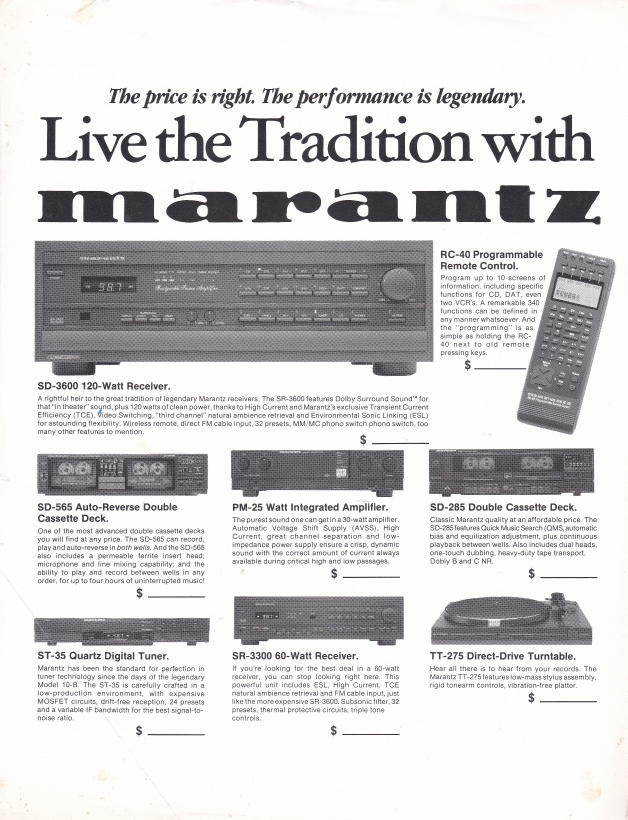1989 MARANTZ SR-3600 DOLBY SURROUND HOME THEATER RECEIVER
120x2 WRMS (Bridged) - Dolby Surround - MC/MM Phono - Pre-Out/Main-Ins - 20 Presets Tuner
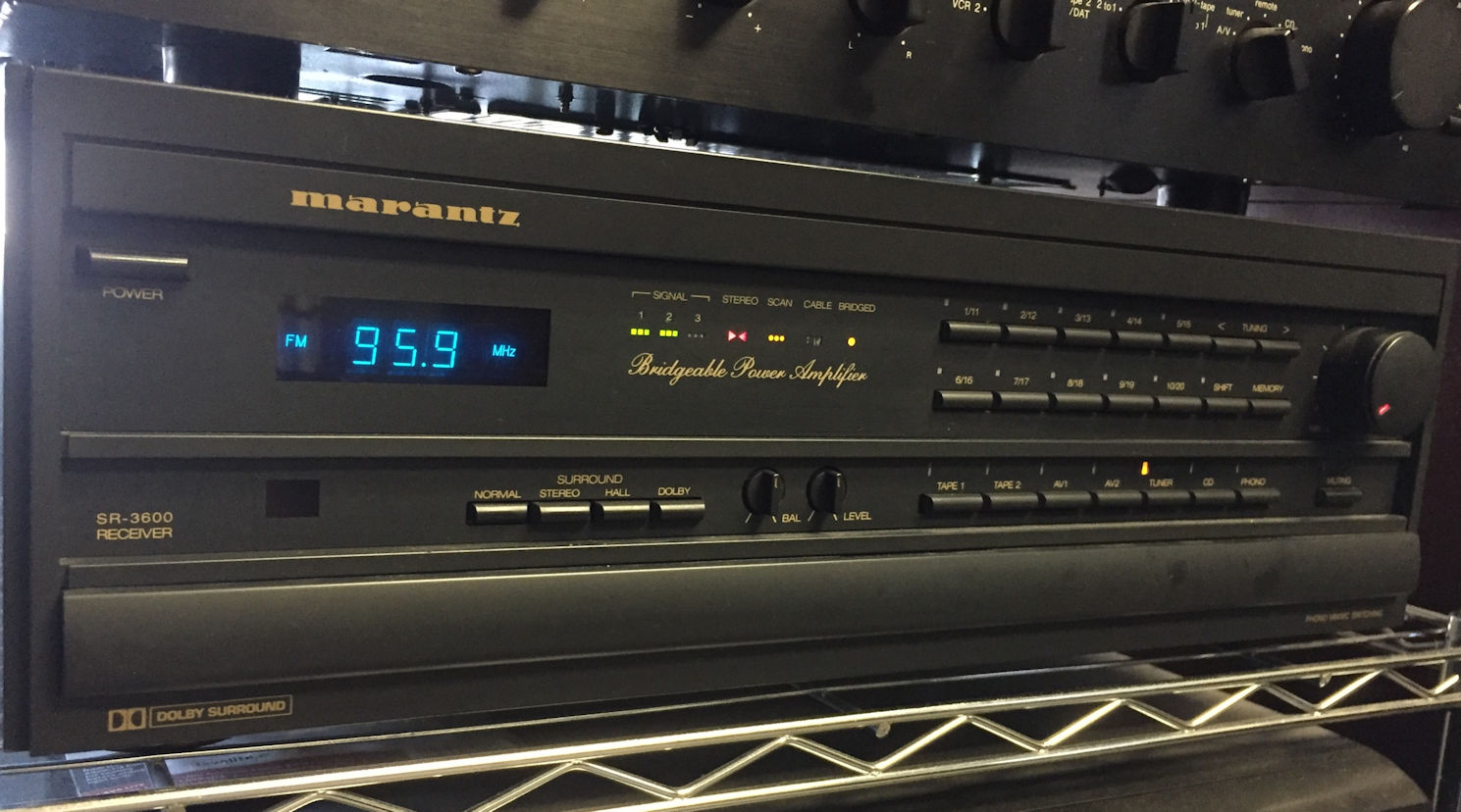 |
|
Presented by
My Favorite Receivers. The 1989 Marantz SR-3600 Receiver, aka the "Century 3600", is probably one of the most vilified Receivers ever marketed. However, it is not without its virtues. It was introduced for 1989 and was Marantz's first attempt at a Home Theater Receiver with Dolby Surround sound and digital signal processor effects. It was the successor to the notorious gold colored Marantz TA-170AV. However, it didn't have the 170's whopping 170 WRMS/ch, dual 5-Band LED EQs, Power Meters or tone defeat. Nor, did it look like "Tokyo at night" when the power was on. I know this is a very obscure receiver, however, from time to time, somone comes across one and is not sure what to make of it. So, as an owner of a nice, pristine one, I've decided to put all I know about it togther in one place and tell its story. I recently acquired a copy of the exteremely rare Owner's Manual (.pdf). Unfortunately, the 3600, with its dark gray plastic face, was a wrong turn styling-wise for Marantz. In fact, the front panel is so plasticy that it is comprised of three strips of plastic, with the nomenclature printed onto them, which were hot glued to the plastic base. This must have turned away most Marantz buyers and the 3600 generally considered the absolute "low point" in design for Marantz receivers. Not surprisingly the glue deteriorates wiith age and the strips fall off so that owners can't even tell which of the myriad buttons to push! As you can see in the photos below, the middle strip on my first 3600 had fallen off and you can see the remnants of rectangular grids where the adhesive had been applied. Even though I gave that one away, I still wanted a perfert one for my Marantz TOTL receiver collection and so I got a perfect one, which is shown in the top photo. |
|||||
|
|
|||||
Unlike prior Top of the Line (TOTL) Marantz Receivers, most of which were manufactured by Standard Radio in Japan, the 3600 was sourced from a factory somewhere in Taiwan, which, supposedly also manufactured comparable NAD and Rotel units. There is a rumor that the manufacturer of the almost identical Vector Research VRX-9200 was NEC. And, I can verify that the 3600, with the exception of the front panel, is virtually identical to the Vector Research VRX-9200R. In fact, to confirm this, I even bought a remote control for a VRX-9200R and it works perfectly with my 3600. Also, the back panels of the 3600 and the VRX-9200R are identical. So, whoever made the VRX-9200R for Vector Research also made the SR-3600, and it sure wasn't Standard Radio of Japan, the manufacturer of all the legendary Marantz receivers, except the Model 18, which was Made In USA. Just take a look at the brochure below for the 1989 Vector Research line of "audiophile"-oriented receivers. They threw in every audio "buzz word" feature in vogue for 1989. |
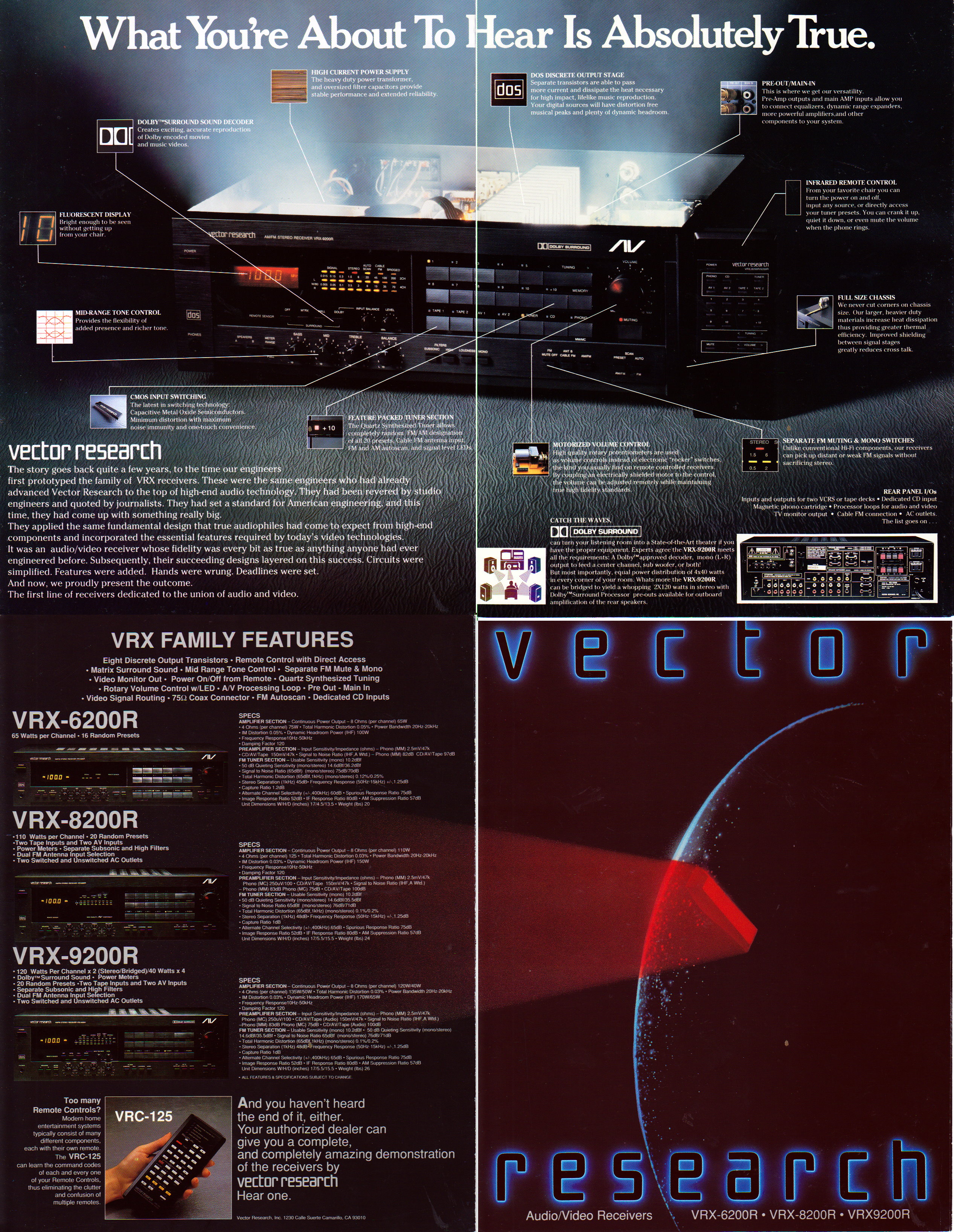 |
If you compare the back panel for the 3600, below, with the back panel for the VRX-9200R, at the middle-right of the brochure, you will see my point. |
||||||||||||||||||||
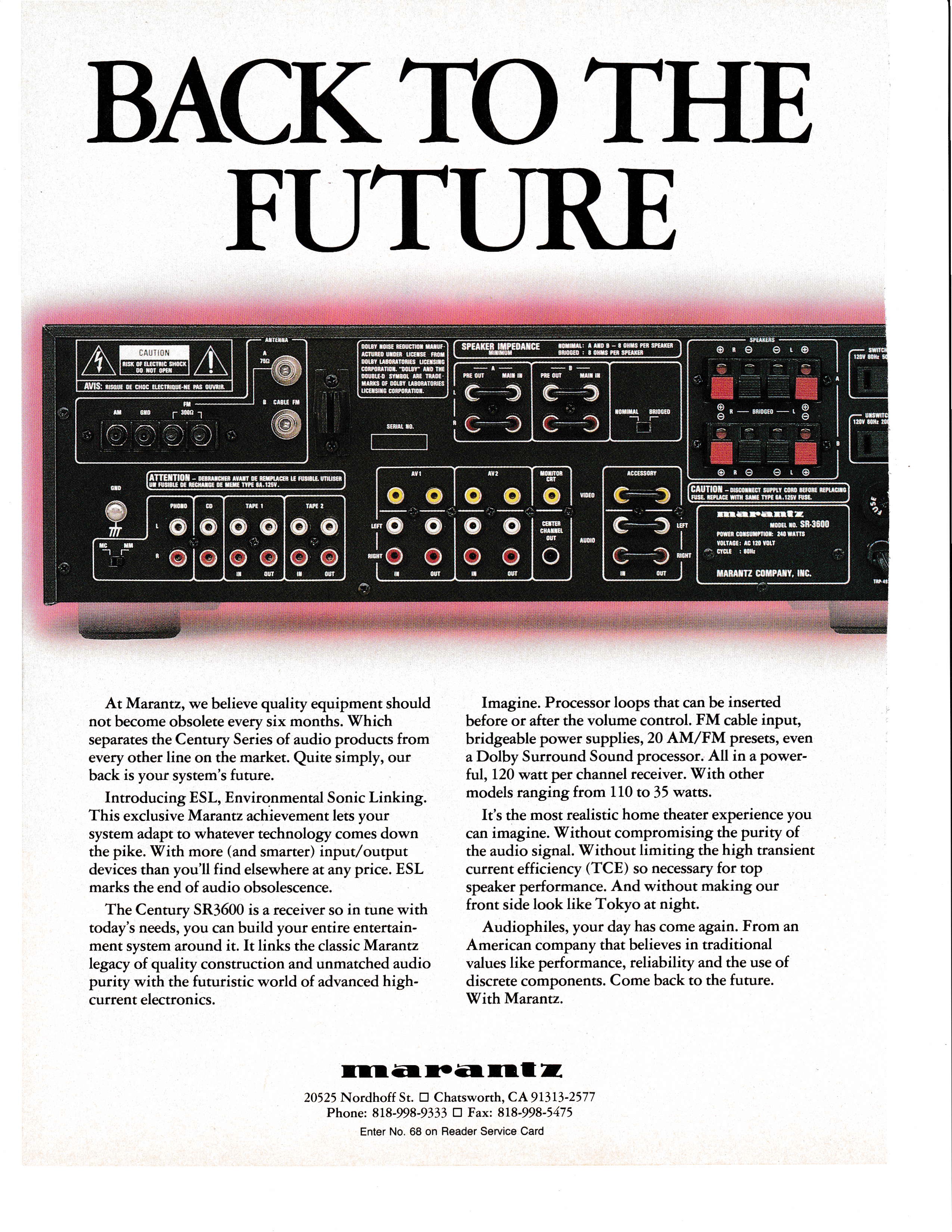 |
||||||||||||||||||||
| In fact, I would go so far as to
say that despite what it looked like up front, the back
panel of the 3600 is about as comprehensive as any TOTL Receiver
of the time. As you can see, the 3600 had a very
extensive back panel, with two
(2) sets of pre out/main ins (A/B) and "ESL linking", which was a
Marantz's term for adding other devices into the signal path as a
way to counter obsolescence. In fact, the "Back to the Future" ad above was the only
advertising
Marantz did to support the 3600. It was most unusual for an ad
not to show the front of a TOTL Receiver. But, in
this case, understandable. The rear was clearly more
appealing to look at. Regardless, the 3600 represented a couple other "firsts" for Marantz in addition to the headlining Dolby Surround: 1) It was the first Marantz Receiver ever with a Moving Coil (MC) phono preamp, which was switchable on the back panel at the lower left (Why this switch was not put in front is a mystery). 2) And, harkening back to an earlier time, the 3600 was also unusual in that it had a Bridgeable Power Amplifer. In normal Surround Sound mode, the two (2) amplifiers were rated at 40 WRMS/ch x 4, however, in bridged mode, the amplifiers could crank out 110 WRMS/ch x2 for stereo. The two (2) filter caps are rated at 12,000 uf at 50V, which is consistent with this level of power output. The switch to bridge is to the left of the speaker connectors. However, to operate in bridged mode, the speaker wires much be configured as noted by "bridged" between the two set of terminals and only to the red terminals. This way they each connect to the seperate amplifier sections. Marantz even saw fit to include a rather complete specifications page: 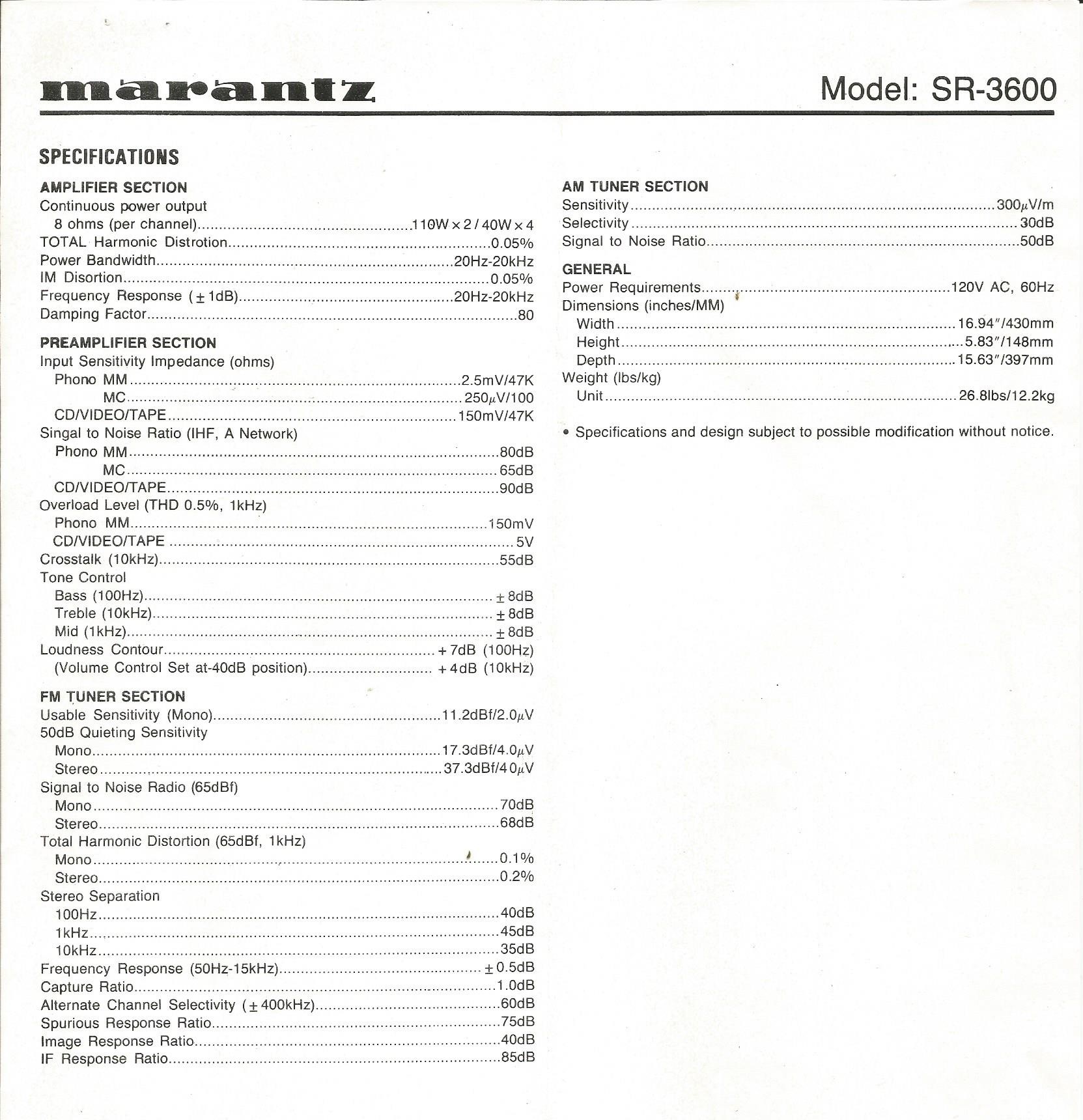 The fllyer below also indicates the the SR-3600 (mis-identified as the SD-3600) also feautures "High Current and Marantz's exclusive Transient Current Efficiency (TCE)", whatever that means. In addition to the standard remote shown above, Marantz also offered one of the earliest "learning" remotes, the RC-40, with an LCD screen. I have the Vector Reasearch learning remote sold with the VRX-9200R, the VRC-125, and it looks nothing like the RC-40 and does not have a screen.
Another interesting feature of the 3600 was the continuing use of Nixie Tube technology in the digital display, like in the TA-170AV, whereas most competitors by this time had gone to electro-floursecent or some form of liquid crystal diodes. If you look carefully at a 3600 you can see the filaments! Other than the Hervic Receiver, the first "digital" receiver (display only, not frequency synthesized like this Marantz) and some of the earliest digitial tuners, I am not aware of any other Receivers using Nixie Tubes, and especially in the late 1980's. The display has a beautiful blue glow. The SR-3600 was also the first Marantz Receiver with remote controllable analog volume control, clearly visible in the lower left of the photo below. And, lastly, it the first with a hidden panel for the secondary controls, a feature that lives on in Marantz's current lineup. This feature was much better implemented in the successor Marantz RS-3559, which was lauded by Julian Hirsch of Stereo Review as one of the most handsome pieces of audio he had seen during his distinguished career. As you can see from the photos below, what appears to be large single heat sink for the amplifier is actually 2 smaller heatsinks stacked on top of each other, each witih four (4) discrete output transistors on each heatsink, for a total of eight (8). The lower amplifier module is not visible. Both Marantz and Vector Reseach touted the discrete output transistors referring to it as "DOS": Discrete Output System design.
|
| |
|
|
||||||||||||
